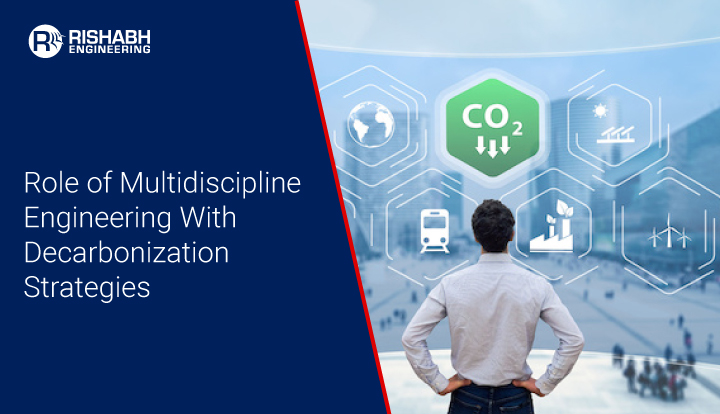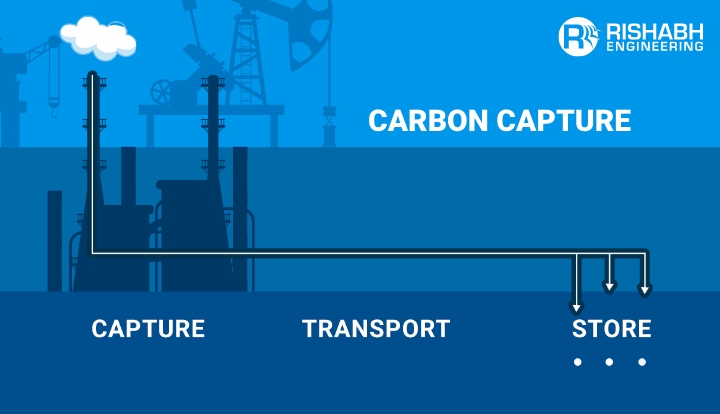
Decarbonization Strategy: Navigating a Sustainable Future
In today’s world of eco-awareness, companies understand the crucial significance of decarbonization in creating a low-carbon tomorrow. Thus, crafting an impactful decarbonization plan is essential for any business looking to succeed in a sustainability-focused society. It is widely accepted that this shift in mindset necessitates a comprehensive tactic that merges creativity, political support, and cooperative endeavors to bring about a fresh age of thoughtful and earth-friendly behavior. The essential need for decarbonization is becoming urgent across industries.

With this article, let’s explore the concept of decarbonization, its importance, potential challenges for adoption, and how a multidiscipline engineering company can help you address challenges with an accurate road map and strategy.
What Is Decarbonization?
Decarbonization, the process of reducing carbon emissions and transitioning towards a low-carbon economy, has gained significant attention in recent years. It involves strategies such as promoting renewable energy sources, improving energy efficiency, and developing new technologies. The importance of decarbonization lies in its potential to mitigate climate change, reduce dependence on fossil fuels, and create new economic opportunities. While decarbonization has challenges, such as political and economic barriers, there is a growing consensus that it is necessary for a sustainable future.
Reducing or eradicating carbon dioxide (CO2) emissions, known as decarbonization, pertains to CO2 emissions generated by human actions that cause the Earth’s climate to warm. This action is intended to decrease greenhouse gas concentrations, including carbon dioxide, methane, and nitrous oxide, in the atmosphere.
Why Is Decarbonization Important?
Reducing carbon emissions is crucial in battling the ever-rising climate crisis. We can all acknowledge that decarbonization has become more than just an environmental obligation; it’s vital for our strategic future. It enables the promotion of worldwide sustainability, the moderation of the repercussions of climate change, and the establishment of a robust foundation for us all.
Listed below are some of the key reasons;
- Mitigating Climate Change: Decarbonization aims to reduce carbon dioxide (CO2) emissions, helping to minimize the adverse effects of climate change, such as rising temperatures, rising sea levels, extreme weather events, and disruptions to ecosystems.
- Environmental Protection: Decarbonization reduces dependence on fossil fuels and reduces the risks of sulfur dioxide, nitrogen oxides, and particulate matter, thereby improving overall environmental quality.
- Energy Security: Relying on diverse energy sources, including renewable and low-carbon options, enhances energy security. Further, decarbonization initiatives reduce the dependence on finite and geopolitically sensitive fossil fuel resources while making them more resilient to supply disruptions and price volatility.
- Health Benefits: Decarbonization can improve public health by reducing air pollution associated with burning fossil fuels. It helps to make air cleaner while decreasing the risk for respiratory and cardiovascular diseases thus reducing healthcare costs and improving overall well-being.
Explore the critical role of Carbon Capture and Storage (CCS) to mitigate emissions. Delve into its workings, and benefits, and discover how multi-disciplinary engineering companies like Rishabh Engineering can help.
Essentials of Decarbonization Strategy
A decarbonization strategy involves planning and implementing measures to reduce or eliminate carbon emissions significantly. This could be associated with a business, organization, or government.
Listed below is a general outline of critical components based on our experience that may be included in a decarbonization strategy:
- Assessment and Baseline Measurement: Conduct a comprehensive assessment of current carbon emissions across all relevant activities. Establish a baseline measurement to understand the starting point and set a reference for future reductions.
- Goal Setting: Define clear and measurable decarbonization goals, such as achieving net-zero carbon emissions by a specific target year. Break down long-term goals into intermediate milestones to track progress.
- Energy Efficiency and Conservation: Implement energy-efficient technologies and practices to reduce energy consumption. Promote conservation measures to minimize waste and optimize resource use.
- Renewable Energy Adoption: It is advised to adopt renewable energy sources such as solar, wind, hydro, or geothermal by investing in on-site renewable energy generation or purchasing renewable energy credits.
- Electrification and Clean Technologies: Replace fossil fuel-powered equipment and vehicles with electric alternatives. Integrate clean technologies, such as carbon capture and storage, where applicable.
- Supply Chain and Procurement: Evaluate and reduce the supply chain’s carbon footprint. Prioritize suppliers with sustainable practices and low-carbon offerings.
- Carbon Offsetting and Removal: Explore carbon offset programs (like reforestation projects) to compensate for emissions that cannot be eliminated.
- Innovation and Research: Foster innovation by investing in research and development of new technologies. Stay informed about emerging solutions and continuously update the strategy accordingly.
- Regulatory Compliance and Advocacy: Stay abreast of and comply with relevant carbon-related regulations. Advocate for supportive policies and regulations at local, national, and international levels.
- Employee and Stakeholder Engagement: Raise awareness and engage employees in sustainability initiatives. Communicate decarbonization efforts transparently to stakeholders and seek their support.
- Monitoring and Reporting: Implement robust monitoring systems to track progress towards decarbonization goals. Provide regular and transparent reports on achievements, challenges, and plans.
- Financial Planning and Investment: Develop a budget and allocate resources for decarbonization initiatives. Seek opportunities for financial incentives, grants, or partnerships to support implementation.
What Are The Potential Decarbonization Challenges?
As discussed above, the decarbonization goals are clear and essential, though achieving them poses several challenges for organizations.
Below are some of the potential challenges associated with adopting the decarbonization process:
- Technological Challenges: Implementing and scaling new technologies for renewable energy, energy storage, and carbon capture and storage (CCS) can be challenging.
- Infrastructure Transition: Transitioning from a fossil fuel-based infrastructure to one based on renewable energy requires significant investments and changes. This is because the upgrade or replacement of existing infrastructure could also turn out to be expensive and time-consuming.
- Economic Considerations: The initial costs of adopting renewable energy and low-carbon technologies may be high, and some industries may resist change due to concerns about financial viability and competitiveness. Balancing economic interests with environmental goals is a crucial challenge.
- Policy and Regulatory Uncertainty: A lack of consistent and supportive policies can hinder decarbonization efforts. To support this clear and stable regulatory frameworks would encourage investments in renewable energy and low-carbon technologies.
- Energy Storage and Intermittency: Renewable energy sources like wind and solar are intermittent, meaning they don’t produce energy consistently.
- Social Acceptance and Equity: Transitioning away from specific industries, such as fossil fuel extraction, can have social and economic implications for communities dependent on those industries.
- Global Cooperation and Commitment: Climate change is a global challenge, and achieving meaningful decarbonization requires international cooperation. Securing agreement and dedication from all nations can prove challenging, particularly when navigating the delicate balance between economic development requirements and environmental objectives.
- Investment Challenges: While there is growing interest in sustainable and green investments, securing sufficient funding for large-scale decarbonization projects may still be a challenge.
Steps For Creating A Successful Decarbonization Roadmap
Developing an effective plan for decarbonization may appear challenging, but simplifying the process into manageable steps can enhance feasibility and success.
Let’s look at the decarbonization steps.
- Identify Quick Wins: Start by identifying immediate actions to lower your carbon footprint. Look for easy-to-decarbonize areas in your operations, such as switching to local or renewable suppliers and upgrading to high-efficiency generators. These quick, easy changes can kick-start your decarbonization journey and energize your organization.
- Embrace Uncertainty: Understand that plans spanning decades may require adjustments. Accept the likelihood of changes in technology or setbacks.
- Collaborate with Experts: Acknowledge that you don’t have all the answers. Consider external partners with expertise in strategic consulting and a broad portfolio of technology solutions. Collaborating with infrastructure experts can help you make informed decisions aligned with your decarbonization objectives.
- Understand Regulatory Landscape: Be aware of emissions, costs, and incentives regulations. A strategic roadmap should account for potential costs tied to emissions and take advantage of available incentives to achieve net-zero goals.
- Embrace Digitization: Integrate digital technologies into your roadmap for better asset monitoring, data measurement, and performance improvement. Digitalization provides a comprehensive view of your infrastructure and facilitates data analysis for informed decision-making.
- Explore Technology Options: Research commercially ready and emerging technologies over the next 30 years. Consider renewable energy sources, electric vehicles, carbon capture, and other low-carbon alternatives. Evaluate their compatibility with your assets and operations.
- Gain Technical Competence: Develop in-depth knowledge about chosen technologies’ timelines, cost curves, and resiliency characteristics. Prioritize technologies based on cost, risk, availability, and scalability.
- Build Adaptability: Anticipate the need for adaptation. Incorporate pre-set checkpoints in your plan to assess progress and consider changes or additions based on evolving technologies or circumstances.
- Prioritize Based on Cost and Risk: Choose technologies and strategies that align with your budget, risk tolerance, and future development plans. Make strategic and informed decisions to prioritize technologies.
- Communicate Effectively: Once your roadmap is developed, use it as a powerful tool to communicate progress. Share updates, challenges, and adaptations with stakeholders. The roadmap serves as a guide to keep everyone informed and aligned with the overall decarbonization destination.
How Can A Multidiscipline Engineering Company Help Develop A Decarbonization Strategy?
Multidiscipline engineering companies bring together various diverse engineering disciplines such as civil, mechanical, electrical, and environmental engineering for decarbonization projects. These firms provide comprehensive solutions that consider the intricate interplay between different aspects of a project. In the context of decarbonization, their role becomes even more critical as they are tasked with developing holistic strategies that address the complexities of reducing carbon footprints across diverse industrial sectors.
A multidisciplinary engineering company like Rishabh Engineering can be crucial in developing a comprehensive and effective decarbonization strategy. Here’s how such a company can contribute to the process:
1. Expertise Across Multiple Disciplines:
- Energy Engineering: They help assess the current energy consumption and identify opportunities for energy efficiency improvements. Recommend and implement renewable energy solutions.
- Mechanical Engineering: The engineering team evaluates and optimizes machinery and equipment to enhance energy efficiency and reduce emissions.
- Civil Engineering: They consider industry best practices to develop sustainable infrastructure design and construction practices to minimize environmental impact.
2. Integrated Systems Thinking: The team takes a holistic approach to decarbonization by considering the interconnectedness of various systems within an organization. This ensures that changes in one area do not inadvertently increase emissions in another.
3. Technological Solutions: By utilizing the latest technologies, they provide insights for decarbonization efforts, such as advancements in renewable energy, energy storage, and carbon capture and storage.
4. Life Cycle Analysis: They conduct life cycle assessments to evaluate the environmental impact of products, processes, and systems. This analysis helps identify areas for improvement and guides sustainable decision-making.
5. Regulatory Compliance: The engineering and design team is well versed with evolving environmental regulations to help the client organization navigate compliance requirements. This ensures that the decarbonization strategy aligns with current and future regulatory expectations.
6. Feasibility Studies: The team conducts feasibility studies to assess various decarbonization options’ viability and their economic implications. This includes evaluating the costs, benefits, and risks of different technologies and initiatives.
7. Carbon Footprint Measurement: They measure and analyze the organization’s carbon footprint while identifying key sources of emissions. This data forms the basis for setting realistic and measurable decarbonization goals.
8. Strategic Consulting: The process engineer provides strategic guidance on developing and implementing a decarbonization roadmap. This includes setting priorities, establishing timelines, and creating a phased approach to achieve long-term goals.
9. Project Management: The team oversees the implementation of decarbonization projects, ensuring they are executed efficiently and within budget. This includes coordinating efforts across different disciplines and managing timelines.
10. Risk Management: The project management team identifies and mitigates risks associated with the decarbonization strategy. This includes anticipating potential challenges, such as technological uncertainties or regulatory changes, and developing contingency plans.
11. Continuous Improvement: The team regularly reassesses the effectiveness of decarbonization initiatives while adjusting the strategy based on lessons learned and emerging opportunities. This is an ongoing improvement process.
12. Training and Awareness: Building awareness and engagement is vital to the strategy’s success. And the project team conducts training programs to educate employees and stakeholders about the importance of decarbonization and how they can contribute to its success.
13. Stakeholder Engagement: The project manager communicates the organization’s commitment to decarbonization and involves stakeholders in the journey. They further engage with employees, customers, investors, and the community at large.
14. Waste Heat Recovery: Waste heat recovery is pivotal in the decarbonization process. It helps synergize diverse engineering disciplines. This approach optimizes industrial processes, capturing and repurposing waste heat for sustainable energy. By integrating mechanical, electrical, and chemical engineering, a multidiscipline engineering company can help reduce the carbon footprint while fostering a greener, more efficient future.
15. Green Buildings: Innovative green building solutions are the need of the hour for sustainable progress. A multidiscipline engineering company can help you seamlessly integrate their specialist skills of architectural, structural, and environmental focus with the decarbonization journey. This holistic approach helps maximize energy efficiency, minimize environmental impact, and foster a resilient built environment that offers a sustainable future for future generations.
16. Process Simulation: A multidiscipline engineering firm can help you optimize industrial processes, minimizing emissions and energy consumption with process simulation as part of comprehensive decarbonization strategies. The simulations guide sustainable innovations, empowering industries to transition towards a low-carbon future while ensuring operational efficiency and economic viability.
Final Words
The decarbonization journey is a complex but necessary endeavor for industries worldwide. And, with the urgent need to reduce carbon emissions, organizations worldwide are turning to decarbonization as a pivotal strategy. This article delves into the challenges and innovative solutions crucial for a successful transition. Recognizing the importance of decarbonization in addressing climate change and promoting sustainability, it highlights critical reasons, from mitigating climate change to improving health and energy security. The outlined essentials of a decarbonization strategy, potential challenges, and steps for creating a successful roadmap provide a comprehensive guide. The collaboration between these firms, industries, and regulatory bodies is paramount in achieving a harmonious balance between economic prosperity and environmental responsibility. With the assistance of multidisciplinary engineering firms like Rishabh Engineering, equipped with diverse expertise, organizations can navigate the complexities and contribute to a sustainable and low-carbon future. They serve as catalysts for change, offering integrated solutions that propel industries toward a sustainable and environmentally responsible future.
Need Help With Decarbonization Strategy?
We can help devise a precise roadmap for an efficient and greener future.

